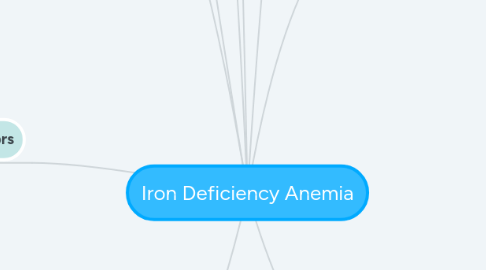
1. Pathophysiology
1.1. The body needs iron to carry oxygen throughout the body, thus there is a constant need for iron.
1.2. With lack of iron there is dysfunction in iron metabolism.
1.3. This metabolic dysfunction causes lack of iron delivery to bone marrow.
1.4. When bleeding occurs, it depletes the irons storage and more iron is loss to replace iron lost from bleeding.
1.5. Develops over 3 stages:
1.5.1. Stage 1: there is no more iron in the body.
1.5.2. Stage 2: there is lack of iron to bone marrow, resulting in red blood cells lacking iron.
1.5.3. Stage 3: new red blood cells lacking iron enter the bloodstream to replace healthy red blood cells. Symptoms are present in this phase.
1.6. (McCance & Rote, 2019).
2. Immunity
2.1. Iron assists the immune system by regulating immune response mechanisms, such as cytokines, interferon and T-cells.
2.2. (McCance & Rote, 2019).
3. Causative/Risk Factors
3.1. Blood loss
3.1.1. Individuals at higher risk:
3.1.1.1. Individuals living in low-income countries
3.1.1.2. Women of childbearing age
3.1.1.3. Children
3.1.2. ● Hemorrhage from trauma ●Hematemesis or melena (blood in vomit or stool. ●Hemoptysis (coughing blood) ●Heavy menstrual period ●Being pregnant and delivering a child ●Hematuria (blood in urine)
3.2. Reduced iron absorption
3.3. Redistribution after erythropoietin/erythropoiesis-stimulating agents
3.4. Urinary/pulmonary hemosiderosis (excess of iron in the body and tissues)
3.5. Inherited disorders such as Iron-refractory iron deficiency anemia (mutation in gene TMPRSS6).
3.6. High-intensity athletics (high intensity activities increase iron losses by as much as 70% compared to no exercise).
3.7. (Auerbach, 2020).
4. Nurse Practitioner (NP) Considerations
4.1. NPs should screen patients for anemia
4.2. They also should evaluate symptoms and laboratory results.
4.3. It is important to start treatment promptly to avoid further complications.
4.4. (Cadet, 2018).
5. Infection
5.1. Acquired hypoferremia might be a form of response to infection.
6. Inflammation
6.1. Anemia could be a nonspecific acute phase response of an inflammation reaction.
7. Diagnostic Tests
7.1. First step: identify and reduce sources of blood loss.
7.2. Complete blood count (CBC) and red blood cell (RBC)
7.3. Iron studies
7.3.1. Serum iron
7.3.2. Serum transferrin
7.3.2.1. Transferrin: blood-plasma glycoprotein; plays a key role in iron metabolism and is responsible for ferric-ion delivery.
7.3.3. Transferrin saturation
7.3.4. Serum ferritin
7.3.4.1. Ferritin: protein that stores iron inside your cells.
7.3.5. Soluble transferrin receptor (sTfR) and sTfR-ferritin index
7.3.6. RBC protoporphyrin and RBC zinc protoporphyrin
7.3.7. Reticulocyte hemoglobin content (CHr)
7.3.8. Bone marrow iron stain
7.3.9. (Auerbach, 2020).
8. Treatments
8.1. Treating underlying conditions
8.2. Oral supplements
8.2.1. Ferrous fumarate
8.2.2. Ferrous gluconate
8.2.3. Ferrous sulfate
8.3. IV supplements
8.3.1. Iron sucrose (Venofer®)
8.3.2. Ferric gluconate (Ferrlecit®)
8.4. Monitoring and hemoglobin/iron targets
8.5. Blood transfusion (whole pack red cells)
8.6. (Auerbach, 2020).
8.7. Side effects associated with oral iron supplements:
8.7.1. Constipation
8.7.2. Nausea
8.7.3. Vomiting
8.7.4. Dyspepsia
8.7.5. (Cadet, 2018).
